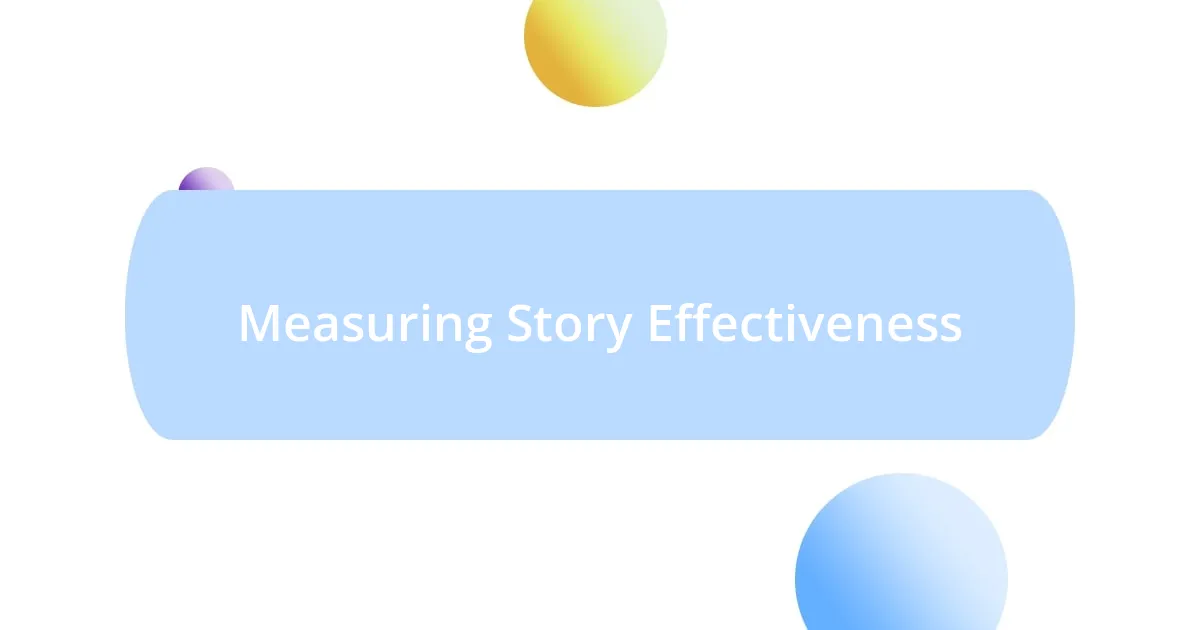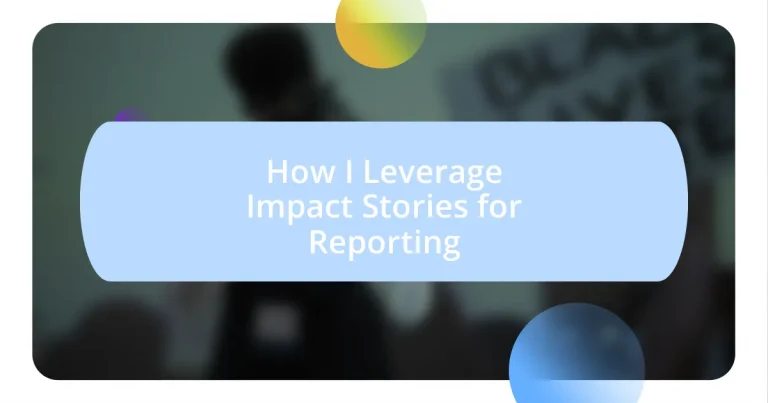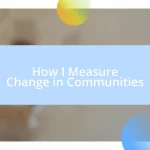Key takeaways:
- Impact stories provide emotional connections and reveal the human experiences behind the data, making complex initiatives relatable and inspiring.
- Key elements to highlight include beneficiary voices, challenges faced, outcomes achieved, and visual elements to create a comprehensive narrative.
- Measuring the effectiveness of stories involves tracking engagement, gathering feedback, and conducting focus groups to understand their impact on audiences.
- Creative communication, using visuals and social media, enhances the presentation of results, transforming statistics into engaging narratives that resonate with the community.

Understanding Impact Stories
Impact stories are powerful narratives that convey the real-life effects of programs, initiatives, or policies. I remember a project where we helped a community access clean water. Hearing the gratitude from families who no longer faced illness was a vivid reminder of our work’s significance. Can you imagine the transformational change this brought to their daily lives?
In my experience, sharing these stories often reveals the human element behind raw data and statistics. When I interviewed a mother who spoke about her child’s health improving due to our educational workshops, it struck me how one personal story can resonate more deeply than any report. Isn’t it fascinating how one voice can echo the larger impact?
These narratives not only highlight achievements but also showcase challenges and lessons learned. I’ve seen firsthand how, during one presentation, a participant broke down while sharing her journey. It hit home for everyone in the room, emphasizing that our work isn’t just numbers; it’s about people, their dreams, and struggles. How do we ensure these voices are heard in a sea of information?

Importance of Impact Stories
Impact stories hold immense importance as they bridge the gap between data and human experience. I’ve seen how a simple tale can encapsulate the essence of a project. For instance, while working on a health initiative, I spoke to a young man whose life was drastically changed after receiving access to mental health resources. His story illuminated the real impact in a way that statistics simply couldn’t convey.
Here are a few key reasons why these stories matter:
– Emotional Connection: They evoke emotions, drawing listeners in and creating empathy, which is crucial for inspiring action.
– Contextual Understanding: Impact stories provide context for the data, helping stakeholders grasp the broader implications and nuances of our work.
– Community Engagement: They foster a sense of community, encouraging others to share their experiences and build a collective narrative.
– Motivation for Improvement: Personal accounts highlight what works and what doesn’t, fueling ongoing improvement in programs and initiatives.
I can’t underestimate the power of storytelling. During a recent workshop, one participant shared her battle with food insecurity. The raw emotion in her voice transformed the room, shifting our focus from statistics to the stark reality some face daily. It served as a powerful reminder that these stories are not just anecdotes; they are call-to-action moments that prompt both reflection and change.

Identifying Key Impact Elements
Identifying key impact elements is like piecing together a puzzle that reveals the larger picture of our work. Each element serves a purpose and tells a part of the story. For instance, I recall a project where we implemented job training programs. By gathering data on employment rates and personal testimonies from graduates, I realized the real impact was not just in numbers but in the newfound confidence and dignity individuals felt. What a profound change that made in their lives!
When I think about the essential elements to highlight, a few stand out: the beneficiaries’ voices, the challenges faced, and the outcomes achieved. I remember interviewing an elderly woman who spoke about her struggle to adapt after losing her home. Her story not only showcased the resilience of the human spirit but also illustrated the importance of support systems we had established. This emphasizes that the key impact elements must resonate on both personal and communal levels.
In my experience, visual elements also add depth to these narratives. I once attended an event where photos of community members who benefited from our programs were displayed alongside their stories. The combination of visuals and words struck a chord, illustrating the impacts in a comprehensive manner. It’s critical to blend emotional, quantitative, and visual elements to create a tapestry of impact that invites questions and inspires action.
| Impact Element | Description |
|---|---|
| Beneficiary Voices | Personal testimonies that encapsulate individual experiences and transformations. |
| Challenges Faced | Details that highlight obstacles encountered, creating a deeper understanding of the journey. |
| Outcomes Achieved | Quantitative and qualitative data showing the effectiveness and results of programs. |
| Visual Elements | Images or infographics that enhance the narrative, making it more relatable and engaging. |

Collecting and Curating Stories
Collecting stories is a dynamic process that transforms raw data into narratives bursting with life. I remember attending a community event where a single conversation with a former program participant revealed untold insights. Sitting across from her, I felt a surge of emotion as she shared how our initiative helped her regain her sense of purpose. It reminded me that sometimes the best stories emerge from simply listening.
Curating these stories means selecting those that encapsulate the essence of our work. I’ve learned that not every story needs to be polished; sometimes, it’s the raw, unfiltered accounts that resonate most. For instance, I once gathered a collection of stories about individuals overcoming adversity. One account described a mother’s struggle to balance job searching with childcare. Her honesty struck a chord, beautifully illustrating the real-world challenges many face. Isn’t it fascinating how one person’s story can shed light on a broader issue?
As I sift through the stories, I think about how they fit together like pieces of a larger mosaic. Each tale complements another, creating a rich narrative tapestry. I often jot down recurring themes during interviews, such as resilience and community support. Reflecting on these connections not only helps me curate impactful stories but also amplifies the voices of those we serve. How often do we overlook the power of collaboration in storytelling? Through this lens, I see not just individual journeys but the shared humanity that binds us all.

Structuring Your Impact Report
Structuring your impact report can feel a bit like crafting a compelling narrative, where each section builds upon the last to create a cohesive story. From my experience, starting with a strong introduction that encapsulates the essence of your work is crucial. I once began a report with a powerful quote from a beneficiary that captured the heart of our mission. The instant connection it created drew readers in so they felt vested in the report from the very beginning.
As I outline the main sections, I think about incorporating testimonials to punctuate the data points. I vividly recall integrating a poignant story from a young man whose life was transformed through our mentoring program. His journey epitomized the statistics I presented, offering a heartwarming counterbalance to the more analytical data. It made me realize how effectively blending narrative with numbers can lead to deeper understanding among readers; they want to know not just what was achieved, but who was affected.
Finally, I always conclude the report by inviting future engagement, posing questions that encourage reflection and action. For instance, I once asked, “How can we all contribute to building a stronger community together?” This simple question not only sparked conversations but also turned passive readers into active participants in our mission. It’s these structural elements that create a report that resonates, educates, and inspires change. Wouldn’t you agree that a well-structured report can be a powerful catalyst for furthering our mission?

Measuring Story Effectiveness
Measuring the effectiveness of impact stories is an art that combines qualitative and quantitative analysis. I often begin by tracking key metrics such as reader engagement, shares, and comments on social media. I recall a campaign where one particularly emotional story generated a flurry of online discussion, revealing not just interest but a genuine connection with the audience. That moment underscored for me that resonance often speaks louder than numbers alone.
Surveys and feedback forms also play a critical role in my assessment process. After sharing impact stories, I’ve found that asking specific questions, like “Which story moved you the most and why?” can yield profound insights. One time, a respondent described how a story about a child’s educational journey inspired her to volunteer, illustrating that storytelling goes beyond mere communication; it can drive actionable change. Isn’t it powerful to think that a single narrative can spark someone’s desire to make a difference?
Additionally, I enjoy hosting focus groups to gain deeper understanding of how stories resonate with different audiences. During one such session, a participant expressed how a shared experience in one story reminded them of their own struggles, creating a bridge of empathy. Moments like these make me realize that effective storytelling transcends demographics; it connects us on a deeply human level. How often do we undervalue the emotional weight behind data? Measuring effectiveness is not just about what people remember, but how they feel and act after engaging with a story.

Communicating Results Creatively
Creative communication of results is where storytelling truly shines. I’ve found that using visuals like infographics or videos can profoundly enhance the way results are perceived. For instance, I once turned a dense report into a short animated video that illustrated key outcomes. The feedback was overwhelmingly positive; not only did it simplify complex data, but it also brought our successes to life in a way that numbers alone simply couldn’t.
In my experience, pairing striking images with narrative elements often deepens engagement. I remember including a photo of a community event alongside a success story about local partnerships. The visual representation made the numbers pop and provided a face to every achievement we discussed. It’s moments like this that make me reflect—how can we use creativity to elevate our communication? The right imagery can evoke emotions, transforming dry statistics into a compelling storyline that resonates deeply with the audience.
Lastly, I’ve started utilizing social media’s immediacy to share bite-sized results. Crafting short, impactful posts that highlight key achievements or testimonials can create a ripple effect of awareness. I recall releasing quick updates during a project, accompanied by powerful quotes from those we served. These snippets garnered attention and fostered an ongoing dialogue with our community. Isn’t it interesting how a simple tweet or post can expand our reach and amplify our impact? This agile approach ensures that our results aren’t just reported; they’re lived and shared.














